Supply Chain Management Report: Komatsu Corporation - Analysis
VerifiedAdded on 2022/09/18
|19
|4675
|25
Report
AI Summary
This report provides a detailed analysis of Komatsu's supply chain management practices. It begins with background information on Komatsu, a Japanese heavy equipment manufacturer, discussing its global presence, product lines, and customer base. The report then delves into the company's supply chain structure, illustrating its global model and use of technology like Komtrax for demand forecasting and communication. It examines Komatsu's sourcing materials and services, highlighting its "Win-Win" and "Same Boat" philosophy with suppliers, and the use of "Zero System" for inventory management. The distribution system is explored, including customer service, order processing, inventory control, and warehousing. Finally, the report suggests improvements, particularly emphasizing the adoption of emerging technologies and environmentally friendly practices to enhance supply chain efficiency and sustainability.
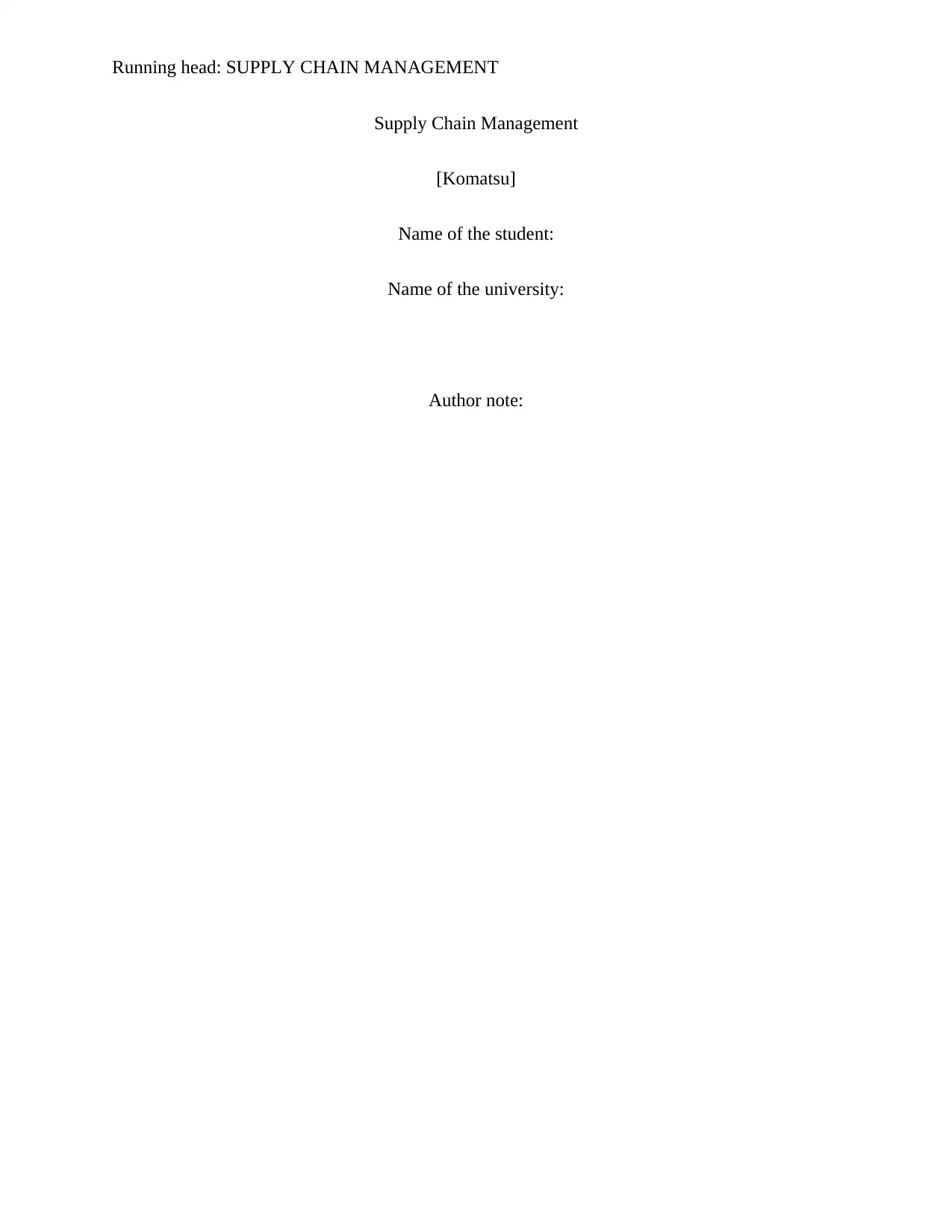
Running head: SUPPLY CHAIN MANAGEMENT
Supply Chain Management
[Komatsu]
Name of the student:
Name of the university:
Author note:
Supply Chain Management
[Komatsu]
Name of the student:
Name of the university:
Author note:
Paraphrase This Document
Need a fresh take? Get an instant paraphrase of this document with our AI Paraphraser
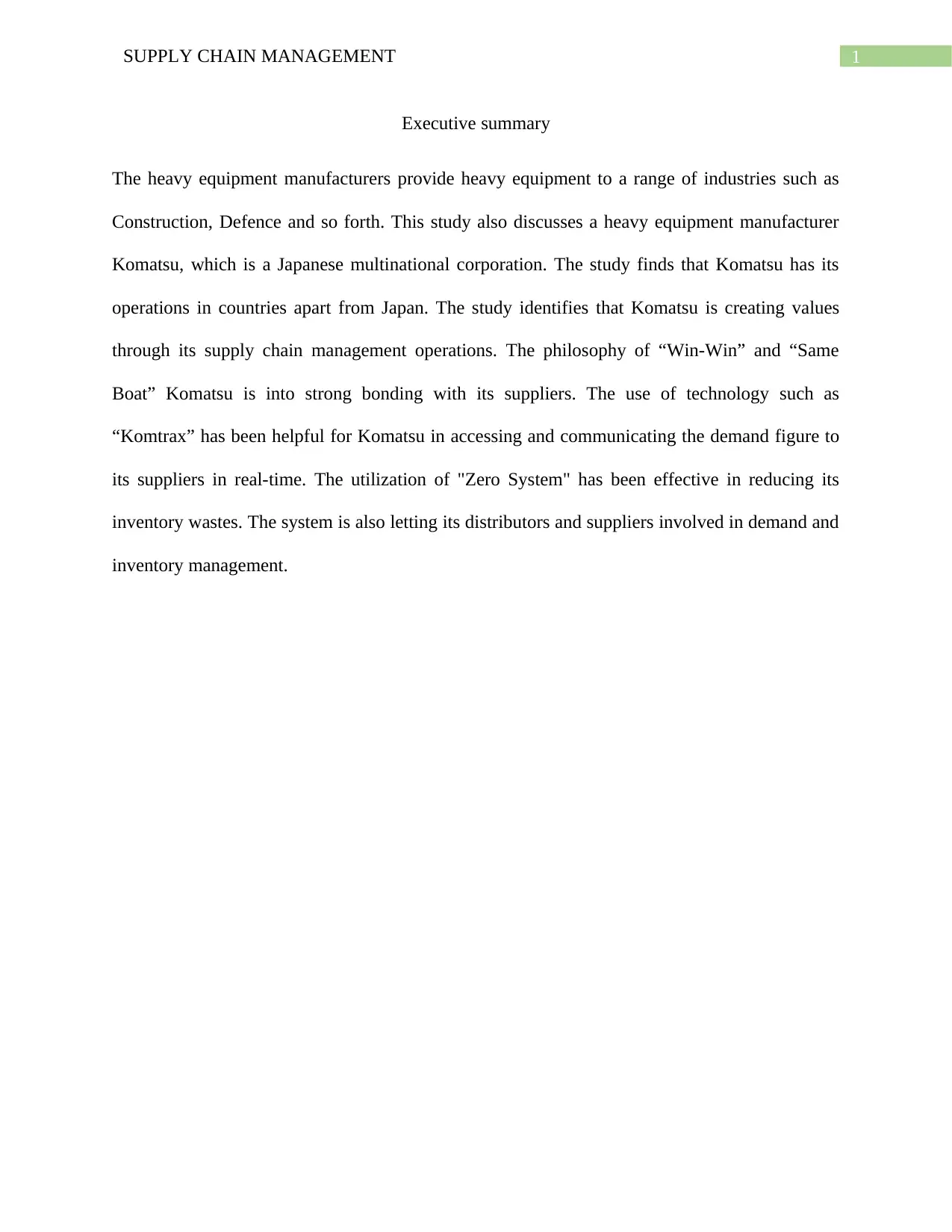
1SUPPLY CHAIN MANAGEMENT
Executive summary
The heavy equipment manufacturers provide heavy equipment to a range of industries such as
Construction, Defence and so forth. This study also discusses a heavy equipment manufacturer
Komatsu, which is a Japanese multinational corporation. The study finds that Komatsu has its
operations in countries apart from Japan. The study identifies that Komatsu is creating values
through its supply chain management operations. The philosophy of “Win-Win” and “Same
Boat” Komatsu is into strong bonding with its suppliers. The use of technology such as
“Komtrax” has been helpful for Komatsu in accessing and communicating the demand figure to
its suppliers in real-time. The utilization of "Zero System" has been effective in reducing its
inventory wastes. The system is also letting its distributors and suppliers involved in demand and
inventory management.
Executive summary
The heavy equipment manufacturers provide heavy equipment to a range of industries such as
Construction, Defence and so forth. This study also discusses a heavy equipment manufacturer
Komatsu, which is a Japanese multinational corporation. The study finds that Komatsu has its
operations in countries apart from Japan. The study identifies that Komatsu is creating values
through its supply chain management operations. The philosophy of “Win-Win” and “Same
Boat” Komatsu is into strong bonding with its suppliers. The use of technology such as
“Komtrax” has been helpful for Komatsu in accessing and communicating the demand figure to
its suppliers in real-time. The utilization of "Zero System" has been effective in reducing its
inventory wastes. The system is also letting its distributors and suppliers involved in demand and
inventory management.
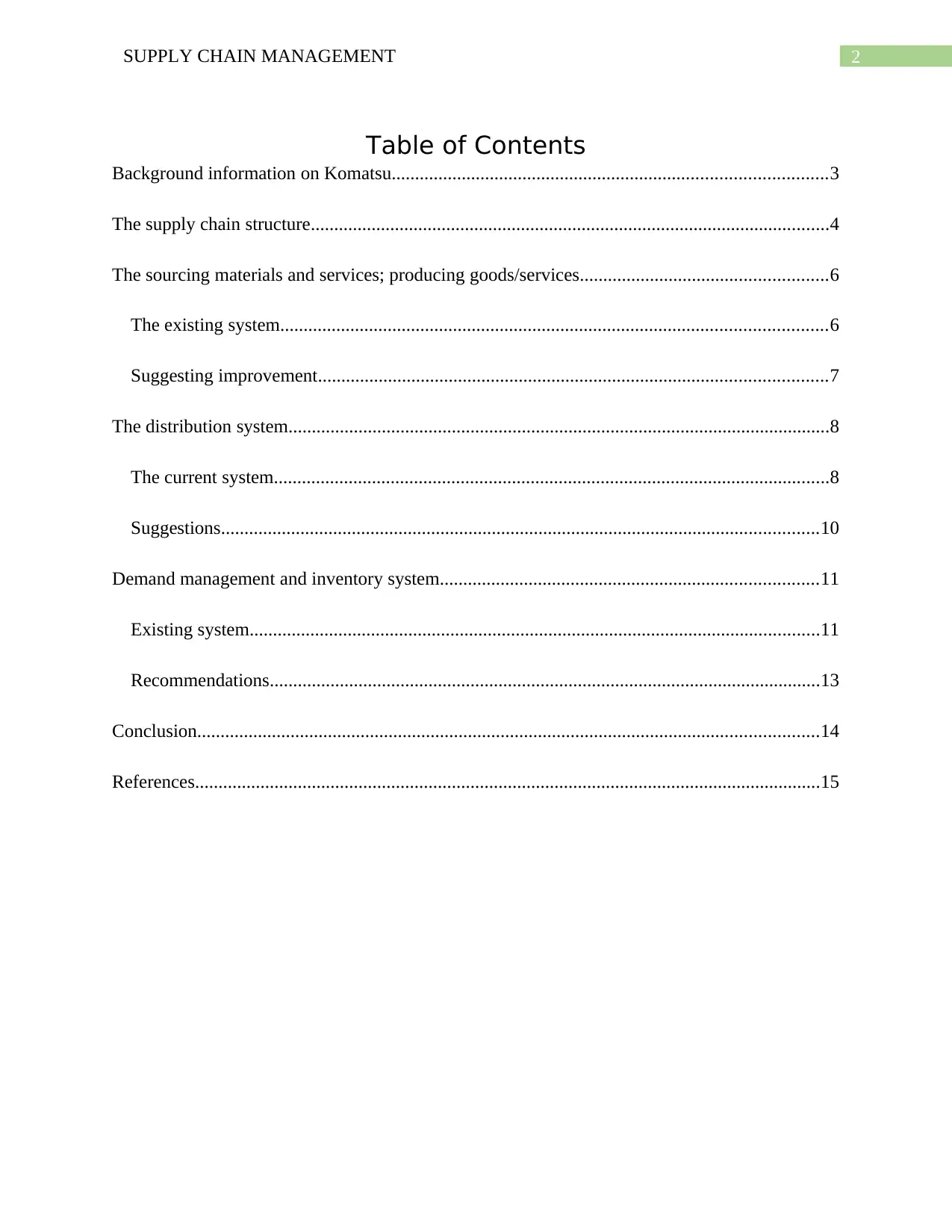
2SUPPLY CHAIN MANAGEMENT
Table of Contents
Background information on Komatsu.............................................................................................3
The supply chain structure...............................................................................................................4
The sourcing materials and services; producing goods/services.....................................................6
The existing system.....................................................................................................................6
Suggesting improvement.............................................................................................................7
The distribution system....................................................................................................................8
The current system.......................................................................................................................8
Suggestions................................................................................................................................10
Demand management and inventory system.................................................................................11
Existing system..........................................................................................................................11
Recommendations......................................................................................................................13
Conclusion.....................................................................................................................................14
References......................................................................................................................................15
Table of Contents
Background information on Komatsu.............................................................................................3
The supply chain structure...............................................................................................................4
The sourcing materials and services; producing goods/services.....................................................6
The existing system.....................................................................................................................6
Suggesting improvement.............................................................................................................7
The distribution system....................................................................................................................8
The current system.......................................................................................................................8
Suggestions................................................................................................................................10
Demand management and inventory system.................................................................................11
Existing system..........................................................................................................................11
Recommendations......................................................................................................................13
Conclusion.....................................................................................................................................14
References......................................................................................................................................15
⊘ This is a preview!⊘
Do you want full access?
Subscribe today to unlock all pages.

Trusted by 1+ million students worldwide
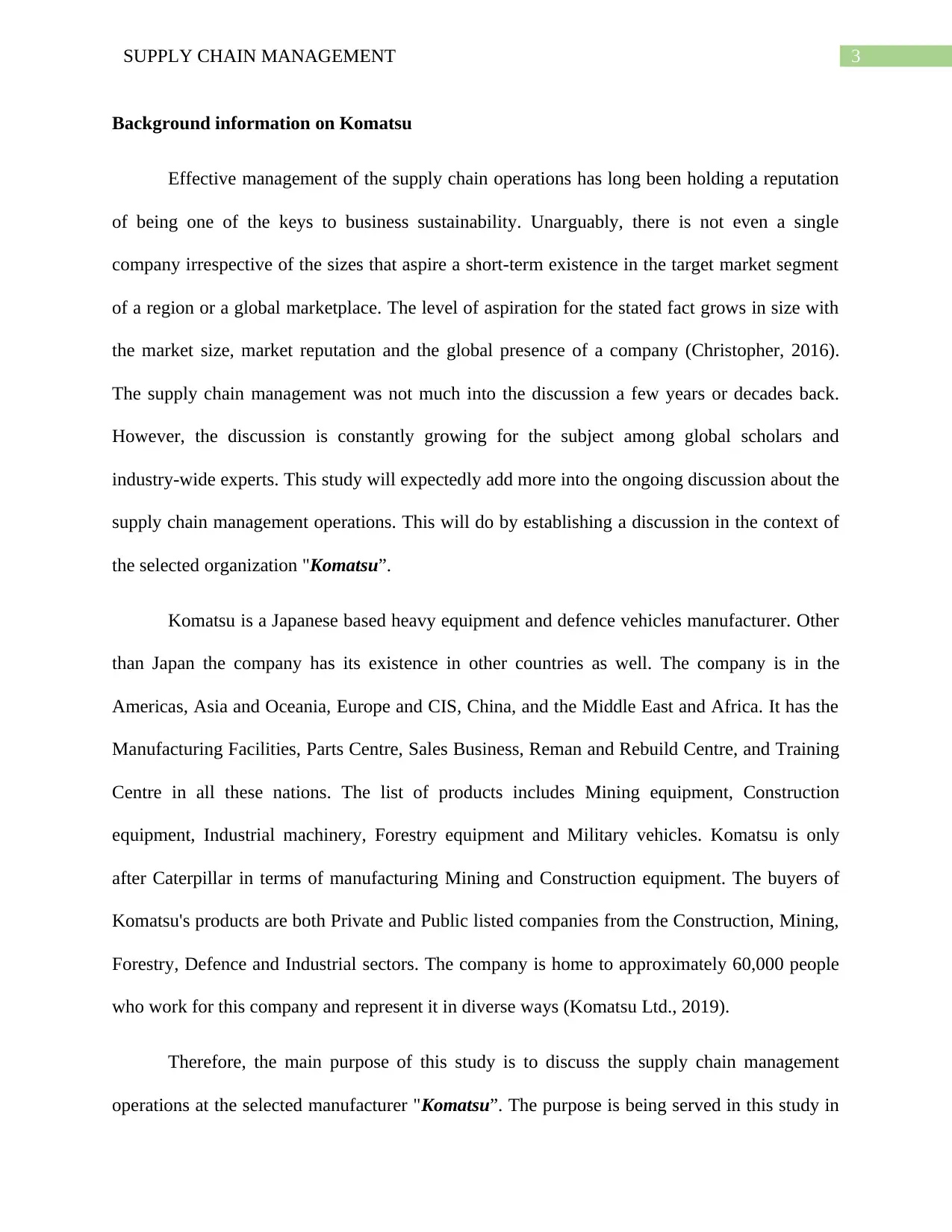
3SUPPLY CHAIN MANAGEMENT
Background information on Komatsu
Effective management of the supply chain operations has long been holding a reputation
of being one of the keys to business sustainability. Unarguably, there is not even a single
company irrespective of the sizes that aspire a short-term existence in the target market segment
of a region or a global marketplace. The level of aspiration for the stated fact grows in size with
the market size, market reputation and the global presence of a company (Christopher, 2016).
The supply chain management was not much into the discussion a few years or decades back.
However, the discussion is constantly growing for the subject among global scholars and
industry-wide experts. This study will expectedly add more into the ongoing discussion about the
supply chain management operations. This will do by establishing a discussion in the context of
the selected organization "Komatsu”.
Komatsu is a Japanese based heavy equipment and defence vehicles manufacturer. Other
than Japan the company has its existence in other countries as well. The company is in the
Americas, Asia and Oceania, Europe and CIS, China, and the Middle East and Africa. It has the
Manufacturing Facilities, Parts Centre, Sales Business, Reman and Rebuild Centre, and Training
Centre in all these nations. The list of products includes Mining equipment, Construction
equipment, Industrial machinery, Forestry equipment and Military vehicles. Komatsu is only
after Caterpillar in terms of manufacturing Mining and Construction equipment. The buyers of
Komatsu's products are both Private and Public listed companies from the Construction, Mining,
Forestry, Defence and Industrial sectors. The company is home to approximately 60,000 people
who work for this company and represent it in diverse ways (Komatsu Ltd., 2019).
Therefore, the main purpose of this study is to discuss the supply chain management
operations at the selected manufacturer "Komatsu”. The purpose is being served in this study in
Background information on Komatsu
Effective management of the supply chain operations has long been holding a reputation
of being one of the keys to business sustainability. Unarguably, there is not even a single
company irrespective of the sizes that aspire a short-term existence in the target market segment
of a region or a global marketplace. The level of aspiration for the stated fact grows in size with
the market size, market reputation and the global presence of a company (Christopher, 2016).
The supply chain management was not much into the discussion a few years or decades back.
However, the discussion is constantly growing for the subject among global scholars and
industry-wide experts. This study will expectedly add more into the ongoing discussion about the
supply chain management operations. This will do by establishing a discussion in the context of
the selected organization "Komatsu”.
Komatsu is a Japanese based heavy equipment and defence vehicles manufacturer. Other
than Japan the company has its existence in other countries as well. The company is in the
Americas, Asia and Oceania, Europe and CIS, China, and the Middle East and Africa. It has the
Manufacturing Facilities, Parts Centre, Sales Business, Reman and Rebuild Centre, and Training
Centre in all these nations. The list of products includes Mining equipment, Construction
equipment, Industrial machinery, Forestry equipment and Military vehicles. Komatsu is only
after Caterpillar in terms of manufacturing Mining and Construction equipment. The buyers of
Komatsu's products are both Private and Public listed companies from the Construction, Mining,
Forestry, Defence and Industrial sectors. The company is home to approximately 60,000 people
who work for this company and represent it in diverse ways (Komatsu Ltd., 2019).
Therefore, the main purpose of this study is to discuss the supply chain management
operations at the selected manufacturer "Komatsu”. The purpose is being served in this study in
Paraphrase This Document
Need a fresh take? Get an instant paraphrase of this document with our AI Paraphraser
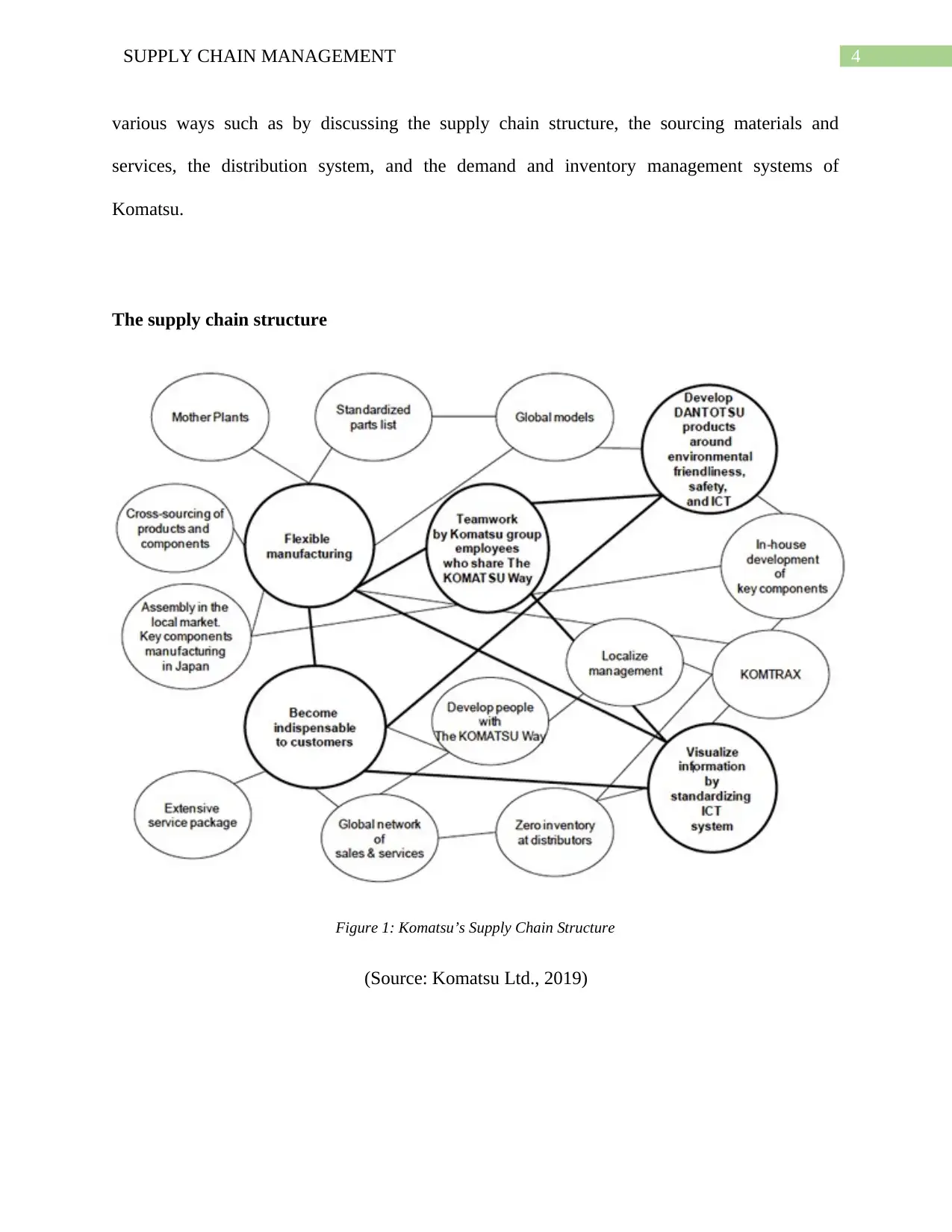
4SUPPLY CHAIN MANAGEMENT
various ways such as by discussing the supply chain structure, the sourcing materials and
services, the distribution system, and the demand and inventory management systems of
Komatsu.
The supply chain structure
Figure 1: Komatsu’s Supply Chain Structure
(Source: Komatsu Ltd., 2019)
various ways such as by discussing the supply chain structure, the sourcing materials and
services, the distribution system, and the demand and inventory management systems of
Komatsu.
The supply chain structure
Figure 1: Komatsu’s Supply Chain Structure
(Source: Komatsu Ltd., 2019)
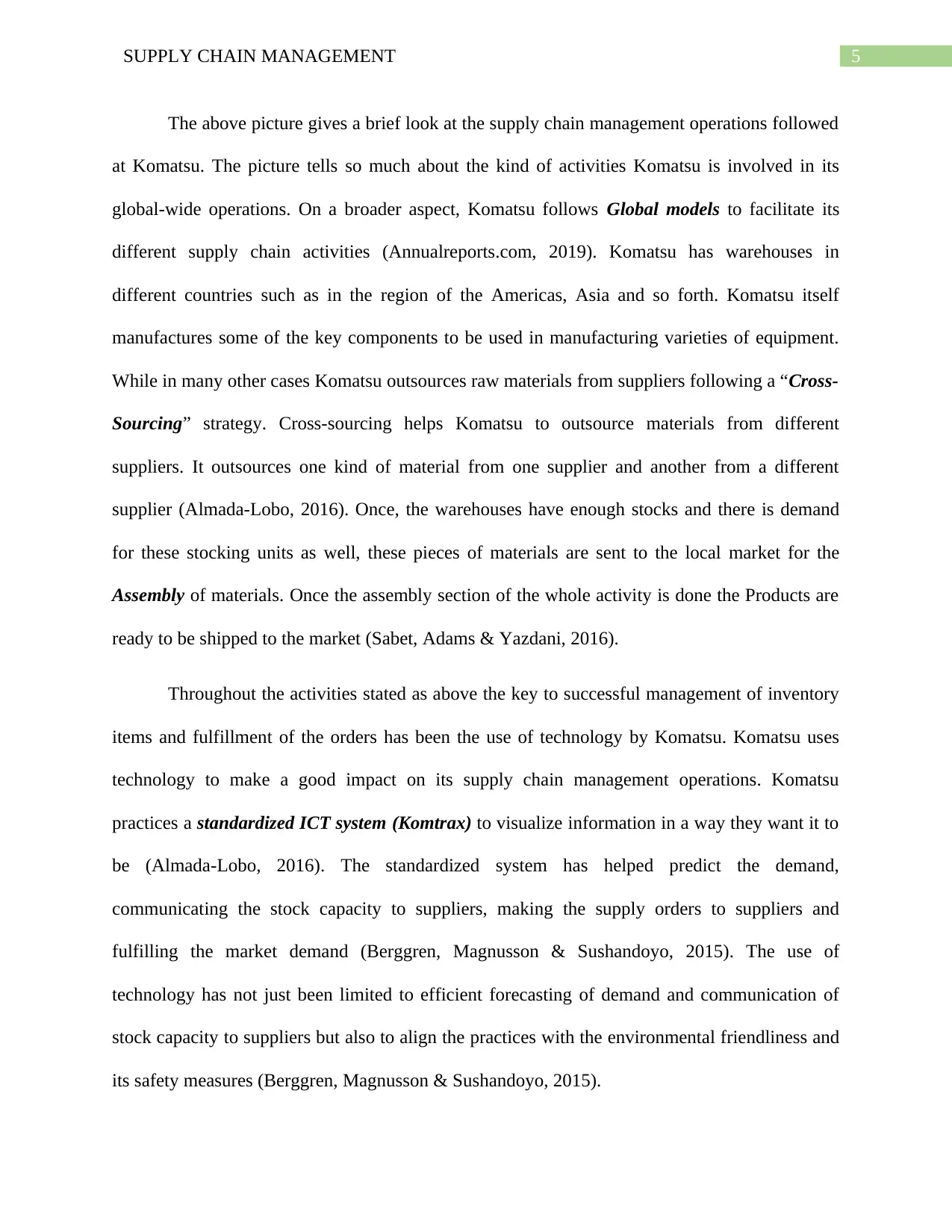
5SUPPLY CHAIN MANAGEMENT
The above picture gives a brief look at the supply chain management operations followed
at Komatsu. The picture tells so much about the kind of activities Komatsu is involved in its
global-wide operations. On a broader aspect, Komatsu follows Global models to facilitate its
different supply chain activities (Annualreports.com, 2019). Komatsu has warehouses in
different countries such as in the region of the Americas, Asia and so forth. Komatsu itself
manufactures some of the key components to be used in manufacturing varieties of equipment.
While in many other cases Komatsu outsources raw materials from suppliers following a “Cross-
Sourcing” strategy. Cross-sourcing helps Komatsu to outsource materials from different
suppliers. It outsources one kind of material from one supplier and another from a different
supplier (Almada-Lobo, 2016). Once, the warehouses have enough stocks and there is demand
for these stocking units as well, these pieces of materials are sent to the local market for the
Assembly of materials. Once the assembly section of the whole activity is done the Products are
ready to be shipped to the market (Sabet, Adams & Yazdani, 2016).
Throughout the activities stated as above the key to successful management of inventory
items and fulfillment of the orders has been the use of technology by Komatsu. Komatsu uses
technology to make a good impact on its supply chain management operations. Komatsu
practices a standardized ICT system (Komtrax) to visualize information in a way they want it to
be (Almada-Lobo, 2016). The standardized system has helped predict the demand,
communicating the stock capacity to suppliers, making the supply orders to suppliers and
fulfilling the market demand (Berggren, Magnusson & Sushandoyo, 2015). The use of
technology has not just been limited to efficient forecasting of demand and communication of
stock capacity to suppliers but also to align the practices with the environmental friendliness and
its safety measures (Berggren, Magnusson & Sushandoyo, 2015).
The above picture gives a brief look at the supply chain management operations followed
at Komatsu. The picture tells so much about the kind of activities Komatsu is involved in its
global-wide operations. On a broader aspect, Komatsu follows Global models to facilitate its
different supply chain activities (Annualreports.com, 2019). Komatsu has warehouses in
different countries such as in the region of the Americas, Asia and so forth. Komatsu itself
manufactures some of the key components to be used in manufacturing varieties of equipment.
While in many other cases Komatsu outsources raw materials from suppliers following a “Cross-
Sourcing” strategy. Cross-sourcing helps Komatsu to outsource materials from different
suppliers. It outsources one kind of material from one supplier and another from a different
supplier (Almada-Lobo, 2016). Once, the warehouses have enough stocks and there is demand
for these stocking units as well, these pieces of materials are sent to the local market for the
Assembly of materials. Once the assembly section of the whole activity is done the Products are
ready to be shipped to the market (Sabet, Adams & Yazdani, 2016).
Throughout the activities stated as above the key to successful management of inventory
items and fulfillment of the orders has been the use of technology by Komatsu. Komatsu uses
technology to make a good impact on its supply chain management operations. Komatsu
practices a standardized ICT system (Komtrax) to visualize information in a way they want it to
be (Almada-Lobo, 2016). The standardized system has helped predict the demand,
communicating the stock capacity to suppliers, making the supply orders to suppliers and
fulfilling the market demand (Berggren, Magnusson & Sushandoyo, 2015). The use of
technology has not just been limited to efficient forecasting of demand and communication of
stock capacity to suppliers but also to align the practices with the environmental friendliness and
its safety measures (Berggren, Magnusson & Sushandoyo, 2015).
⊘ This is a preview!⊘
Do you want full access?
Subscribe today to unlock all pages.

Trusted by 1+ million students worldwide
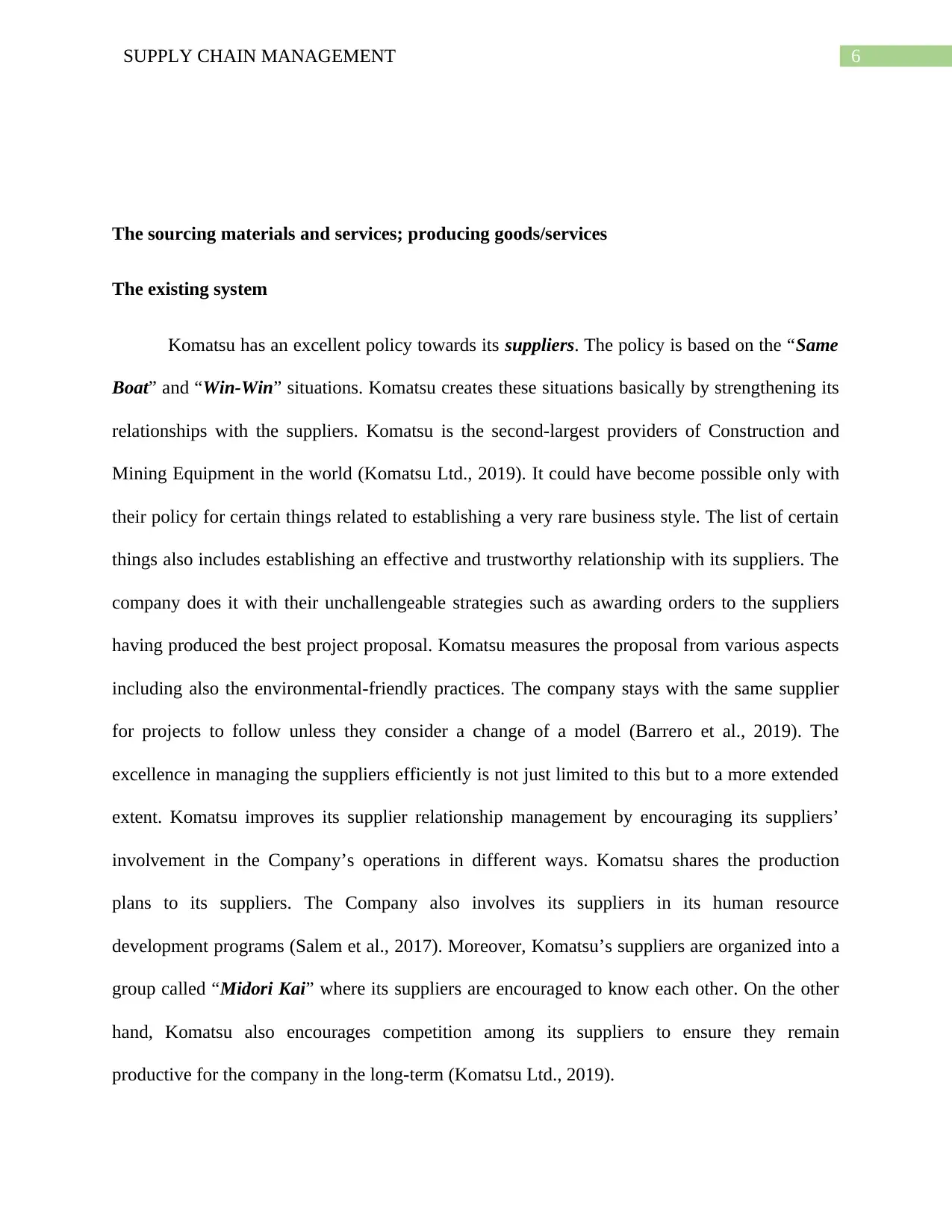
6SUPPLY CHAIN MANAGEMENT
The sourcing materials and services; producing goods/services
The existing system
Komatsu has an excellent policy towards its suppliers. The policy is based on the “Same
Boat” and “Win-Win” situations. Komatsu creates these situations basically by strengthening its
relationships with the suppliers. Komatsu is the second-largest providers of Construction and
Mining Equipment in the world (Komatsu Ltd., 2019). It could have become possible only with
their policy for certain things related to establishing a very rare business style. The list of certain
things also includes establishing an effective and trustworthy relationship with its suppliers. The
company does it with their unchallengeable strategies such as awarding orders to the suppliers
having produced the best project proposal. Komatsu measures the proposal from various aspects
including also the environmental-friendly practices. The company stays with the same supplier
for projects to follow unless they consider a change of a model (Barrero et al., 2019). The
excellence in managing the suppliers efficiently is not just limited to this but to a more extended
extent. Komatsu improves its supplier relationship management by encouraging its suppliers’
involvement in the Company’s operations in different ways. Komatsu shares the production
plans to its suppliers. The Company also involves its suppliers in its human resource
development programs (Salem et al., 2017). Moreover, Komatsu’s suppliers are organized into a
group called “Midori Kai” where its suppliers are encouraged to know each other. On the other
hand, Komatsu also encourages competition among its suppliers to ensure they remain
productive for the company in the long-term (Komatsu Ltd., 2019).
The sourcing materials and services; producing goods/services
The existing system
Komatsu has an excellent policy towards its suppliers. The policy is based on the “Same
Boat” and “Win-Win” situations. Komatsu creates these situations basically by strengthening its
relationships with the suppliers. Komatsu is the second-largest providers of Construction and
Mining Equipment in the world (Komatsu Ltd., 2019). It could have become possible only with
their policy for certain things related to establishing a very rare business style. The list of certain
things also includes establishing an effective and trustworthy relationship with its suppliers. The
company does it with their unchallengeable strategies such as awarding orders to the suppliers
having produced the best project proposal. Komatsu measures the proposal from various aspects
including also the environmental-friendly practices. The company stays with the same supplier
for projects to follow unless they consider a change of a model (Barrero et al., 2019). The
excellence in managing the suppliers efficiently is not just limited to this but to a more extended
extent. Komatsu improves its supplier relationship management by encouraging its suppliers’
involvement in the Company’s operations in different ways. Komatsu shares the production
plans to its suppliers. The Company also involves its suppliers in its human resource
development programs (Salem et al., 2017). Moreover, Komatsu’s suppliers are organized into a
group called “Midori Kai” where its suppliers are encouraged to know each other. On the other
hand, Komatsu also encourages competition among its suppliers to ensure they remain
productive for the company in the long-term (Komatsu Ltd., 2019).
Paraphrase This Document
Need a fresh take? Get an instant paraphrase of this document with our AI Paraphraser
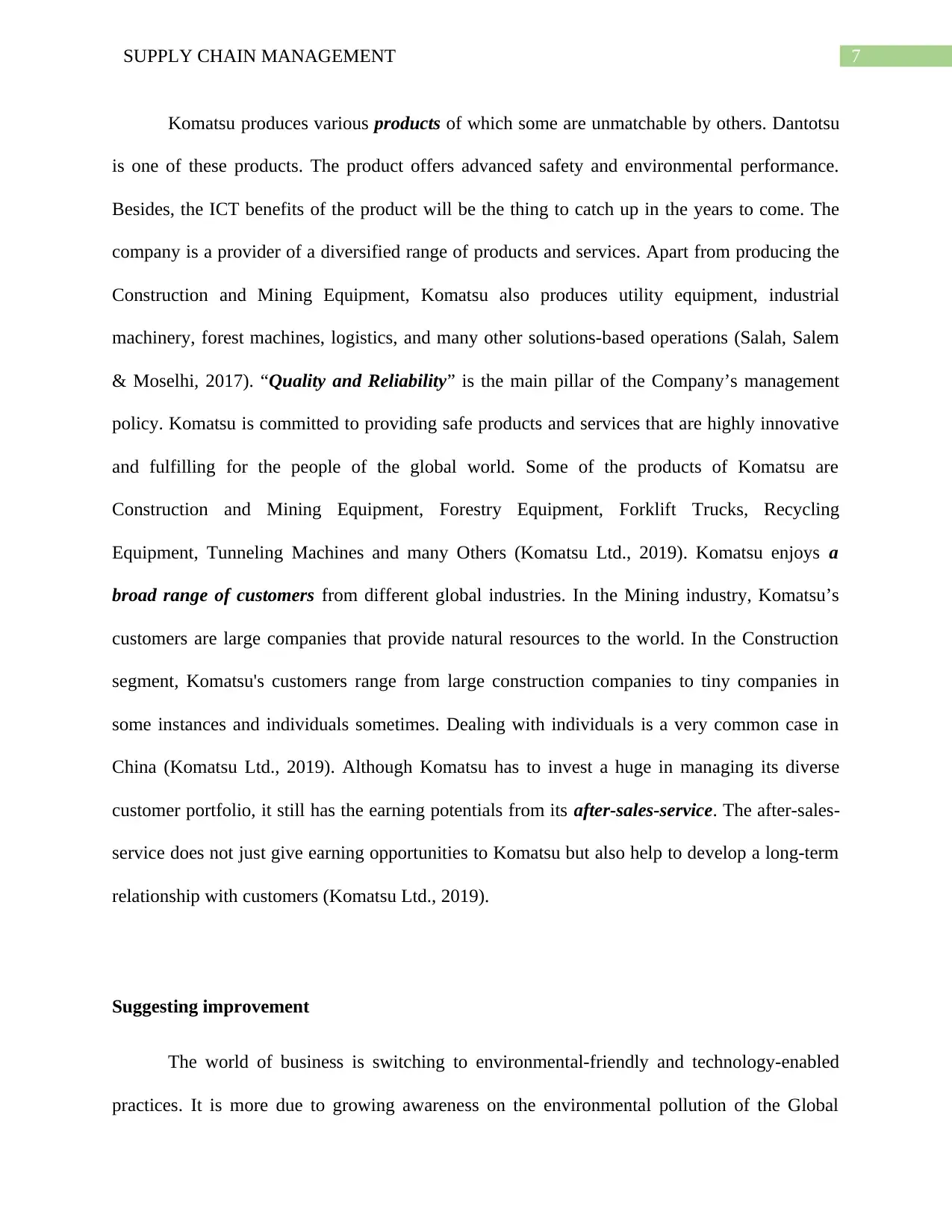
7SUPPLY CHAIN MANAGEMENT
Komatsu produces various products of which some are unmatchable by others. Dantotsu
is one of these products. The product offers advanced safety and environmental performance.
Besides, the ICT benefits of the product will be the thing to catch up in the years to come. The
company is a provider of a diversified range of products and services. Apart from producing the
Construction and Mining Equipment, Komatsu also produces utility equipment, industrial
machinery, forest machines, logistics, and many other solutions-based operations (Salah, Salem
& Moselhi, 2017). “Quality and Reliability” is the main pillar of the Company’s management
policy. Komatsu is committed to providing safe products and services that are highly innovative
and fulfilling for the people of the global world. Some of the products of Komatsu are
Construction and Mining Equipment, Forestry Equipment, Forklift Trucks, Recycling
Equipment, Tunneling Machines and many Others (Komatsu Ltd., 2019). Komatsu enjoys a
broad range of customers from different global industries. In the Mining industry, Komatsu’s
customers are large companies that provide natural resources to the world. In the Construction
segment, Komatsu's customers range from large construction companies to tiny companies in
some instances and individuals sometimes. Dealing with individuals is a very common case in
China (Komatsu Ltd., 2019). Although Komatsu has to invest a huge in managing its diverse
customer portfolio, it still has the earning potentials from its after-sales-service. The after-sales-
service does not just give earning opportunities to Komatsu but also help to develop a long-term
relationship with customers (Komatsu Ltd., 2019).
Suggesting improvement
The world of business is switching to environmental-friendly and technology-enabled
practices. It is more due to growing awareness on the environmental pollution of the Global
Komatsu produces various products of which some are unmatchable by others. Dantotsu
is one of these products. The product offers advanced safety and environmental performance.
Besides, the ICT benefits of the product will be the thing to catch up in the years to come. The
company is a provider of a diversified range of products and services. Apart from producing the
Construction and Mining Equipment, Komatsu also produces utility equipment, industrial
machinery, forest machines, logistics, and many other solutions-based operations (Salah, Salem
& Moselhi, 2017). “Quality and Reliability” is the main pillar of the Company’s management
policy. Komatsu is committed to providing safe products and services that are highly innovative
and fulfilling for the people of the global world. Some of the products of Komatsu are
Construction and Mining Equipment, Forestry Equipment, Forklift Trucks, Recycling
Equipment, Tunneling Machines and many Others (Komatsu Ltd., 2019). Komatsu enjoys a
broad range of customers from different global industries. In the Mining industry, Komatsu’s
customers are large companies that provide natural resources to the world. In the Construction
segment, Komatsu's customers range from large construction companies to tiny companies in
some instances and individuals sometimes. Dealing with individuals is a very common case in
China (Komatsu Ltd., 2019). Although Komatsu has to invest a huge in managing its diverse
customer portfolio, it still has the earning potentials from its after-sales-service. The after-sales-
service does not just give earning opportunities to Komatsu but also help to develop a long-term
relationship with customers (Komatsu Ltd., 2019).
Suggesting improvement
The world of business is switching to environmental-friendly and technology-enabled
practices. It is more due to growing awareness on the environmental pollution of the Global
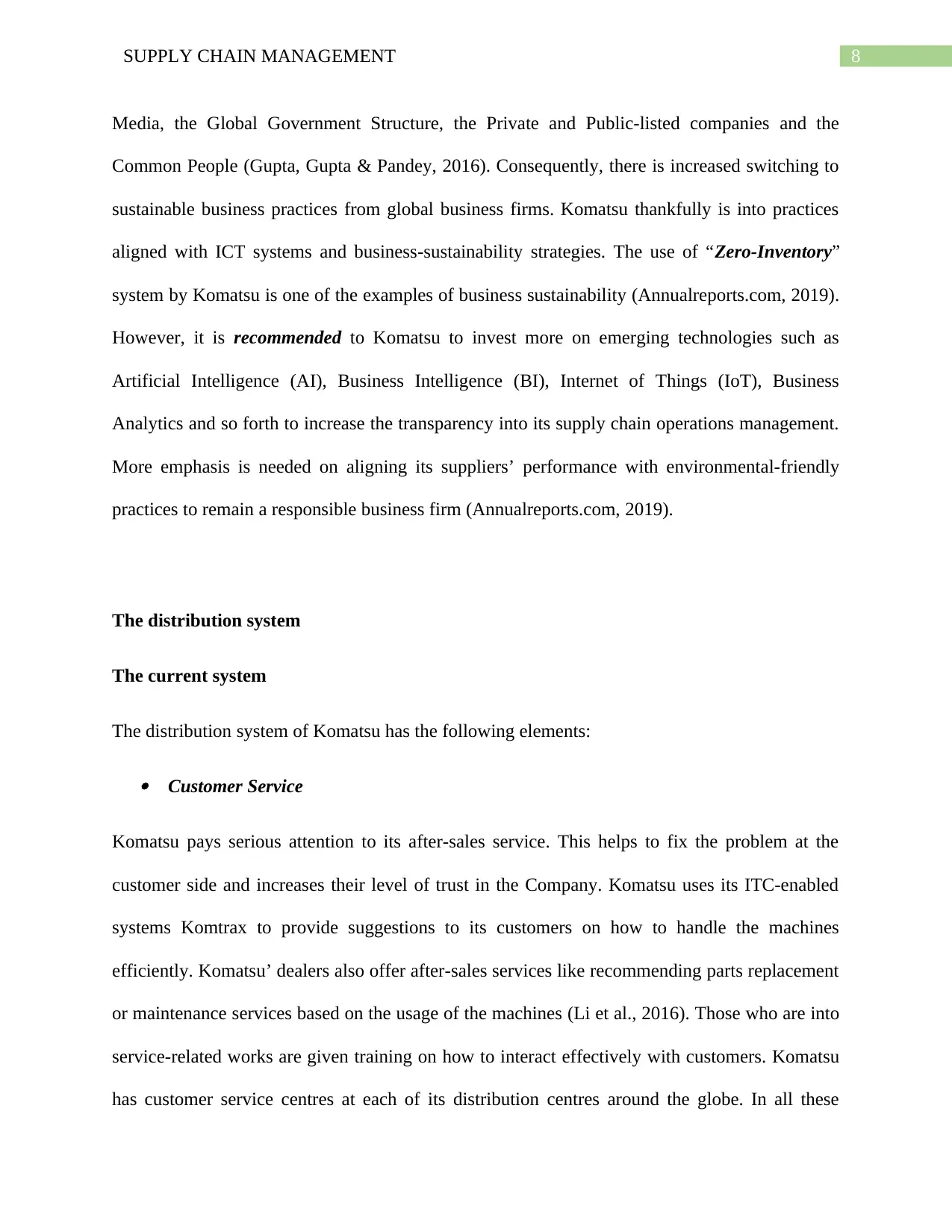
8SUPPLY CHAIN MANAGEMENT
Media, the Global Government Structure, the Private and Public-listed companies and the
Common People (Gupta, Gupta & Pandey, 2016). Consequently, there is increased switching to
sustainable business practices from global business firms. Komatsu thankfully is into practices
aligned with ICT systems and business-sustainability strategies. The use of “Zero-Inventory”
system by Komatsu is one of the examples of business sustainability (Annualreports.com, 2019).
However, it is recommended to Komatsu to invest more on emerging technologies such as
Artificial Intelligence (AI), Business Intelligence (BI), Internet of Things (IoT), Business
Analytics and so forth to increase the transparency into its supply chain operations management.
More emphasis is needed on aligning its suppliers’ performance with environmental-friendly
practices to remain a responsible business firm (Annualreports.com, 2019).
The distribution system
The current system
The distribution system of Komatsu has the following elements:
Customer Service
Komatsu pays serious attention to its after-sales service. This helps to fix the problem at the
customer side and increases their level of trust in the Company. Komatsu uses its ITC-enabled
systems Komtrax to provide suggestions to its customers on how to handle the machines
efficiently. Komatsu’ dealers also offer after-sales services like recommending parts replacement
or maintenance services based on the usage of the machines (Li et al., 2016). Those who are into
service-related works are given training on how to interact effectively with customers. Komatsu
has customer service centres at each of its distribution centres around the globe. In all these
Media, the Global Government Structure, the Private and Public-listed companies and the
Common People (Gupta, Gupta & Pandey, 2016). Consequently, there is increased switching to
sustainable business practices from global business firms. Komatsu thankfully is into practices
aligned with ICT systems and business-sustainability strategies. The use of “Zero-Inventory”
system by Komatsu is one of the examples of business sustainability (Annualreports.com, 2019).
However, it is recommended to Komatsu to invest more on emerging technologies such as
Artificial Intelligence (AI), Business Intelligence (BI), Internet of Things (IoT), Business
Analytics and so forth to increase the transparency into its supply chain operations management.
More emphasis is needed on aligning its suppliers’ performance with environmental-friendly
practices to remain a responsible business firm (Annualreports.com, 2019).
The distribution system
The current system
The distribution system of Komatsu has the following elements:
Customer Service
Komatsu pays serious attention to its after-sales service. This helps to fix the problem at the
customer side and increases their level of trust in the Company. Komatsu uses its ITC-enabled
systems Komtrax to provide suggestions to its customers on how to handle the machines
efficiently. Komatsu’ dealers also offer after-sales services like recommending parts replacement
or maintenance services based on the usage of the machines (Li et al., 2016). Those who are into
service-related works are given training on how to interact effectively with customers. Komatsu
has customer service centres at each of its distribution centres around the globe. In all these
⊘ This is a preview!⊘
Do you want full access?
Subscribe today to unlock all pages.

Trusted by 1+ million students worldwide
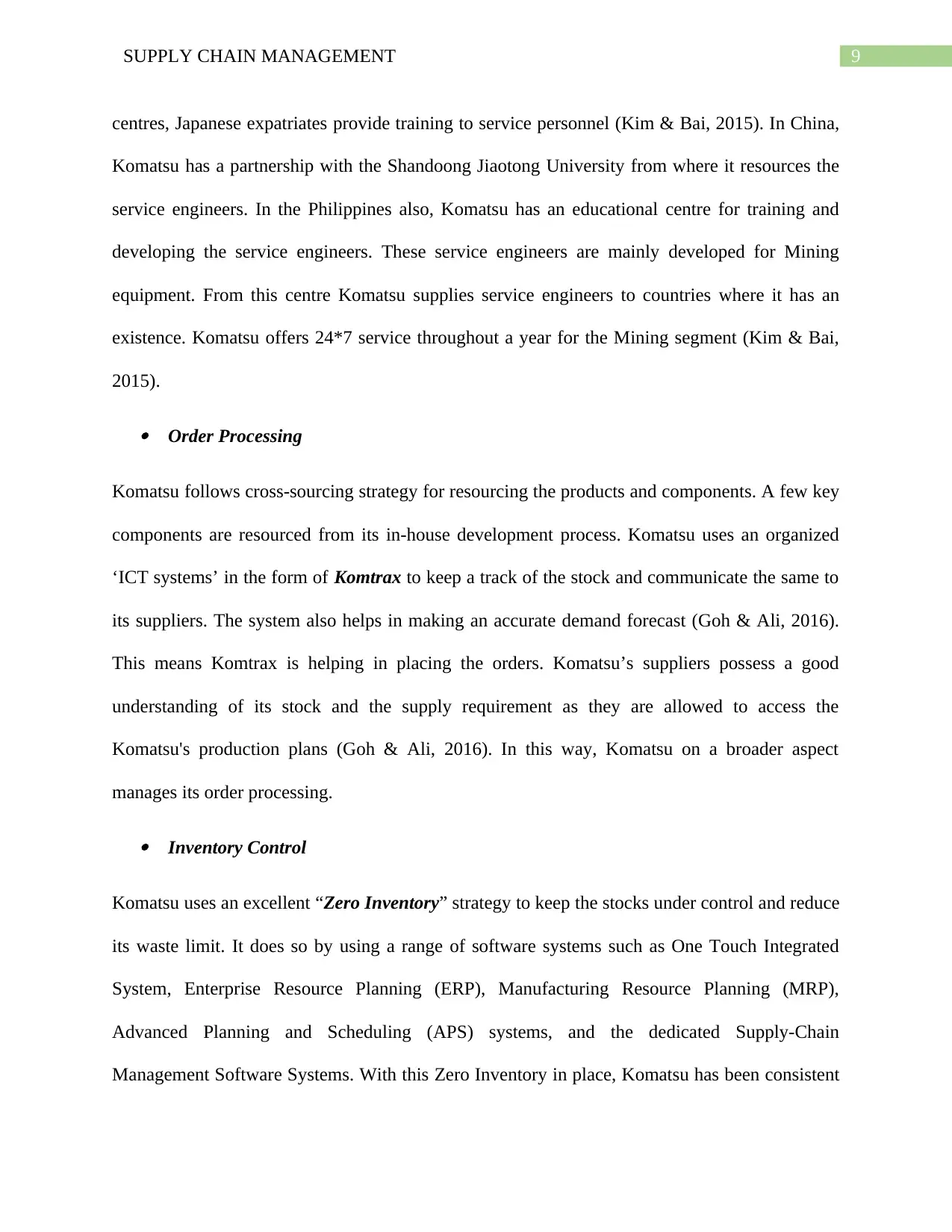
9SUPPLY CHAIN MANAGEMENT
centres, Japanese expatriates provide training to service personnel (Kim & Bai, 2015). In China,
Komatsu has a partnership with the Shandoong Jiaotong University from where it resources the
service engineers. In the Philippines also, Komatsu has an educational centre for training and
developing the service engineers. These service engineers are mainly developed for Mining
equipment. From this centre Komatsu supplies service engineers to countries where it has an
existence. Komatsu offers 24*7 service throughout a year for the Mining segment (Kim & Bai,
2015).
Order Processing
Komatsu follows cross-sourcing strategy for resourcing the products and components. A few key
components are resourced from its in-house development process. Komatsu uses an organized
‘ICT systems’ in the form of Komtrax to keep a track of the stock and communicate the same to
its suppliers. The system also helps in making an accurate demand forecast (Goh & Ali, 2016).
This means Komtrax is helping in placing the orders. Komatsu’s suppliers possess a good
understanding of its stock and the supply requirement as they are allowed to access the
Komatsu's production plans (Goh & Ali, 2016). In this way, Komatsu on a broader aspect
manages its order processing.
Inventory Control
Komatsu uses an excellent “Zero Inventory” strategy to keep the stocks under control and reduce
its waste limit. It does so by using a range of software systems such as One Touch Integrated
System, Enterprise Resource Planning (ERP), Manufacturing Resource Planning (MRP),
Advanced Planning and Scheduling (APS) systems, and the dedicated Supply-Chain
Management Software Systems. With this Zero Inventory in place, Komatsu has been consistent
centres, Japanese expatriates provide training to service personnel (Kim & Bai, 2015). In China,
Komatsu has a partnership with the Shandoong Jiaotong University from where it resources the
service engineers. In the Philippines also, Komatsu has an educational centre for training and
developing the service engineers. These service engineers are mainly developed for Mining
equipment. From this centre Komatsu supplies service engineers to countries where it has an
existence. Komatsu offers 24*7 service throughout a year for the Mining segment (Kim & Bai,
2015).
Order Processing
Komatsu follows cross-sourcing strategy for resourcing the products and components. A few key
components are resourced from its in-house development process. Komatsu uses an organized
‘ICT systems’ in the form of Komtrax to keep a track of the stock and communicate the same to
its suppliers. The system also helps in making an accurate demand forecast (Goh & Ali, 2016).
This means Komtrax is helping in placing the orders. Komatsu’s suppliers possess a good
understanding of its stock and the supply requirement as they are allowed to access the
Komatsu's production plans (Goh & Ali, 2016). In this way, Komatsu on a broader aspect
manages its order processing.
Inventory Control
Komatsu uses an excellent “Zero Inventory” strategy to keep the stocks under control and reduce
its waste limit. It does so by using a range of software systems such as One Touch Integrated
System, Enterprise Resource Planning (ERP), Manufacturing Resource Planning (MRP),
Advanced Planning and Scheduling (APS) systems, and the dedicated Supply-Chain
Management Software Systems. With this Zero Inventory in place, Komatsu has been consistent
Paraphrase This Document
Need a fresh take? Get an instant paraphrase of this document with our AI Paraphraser
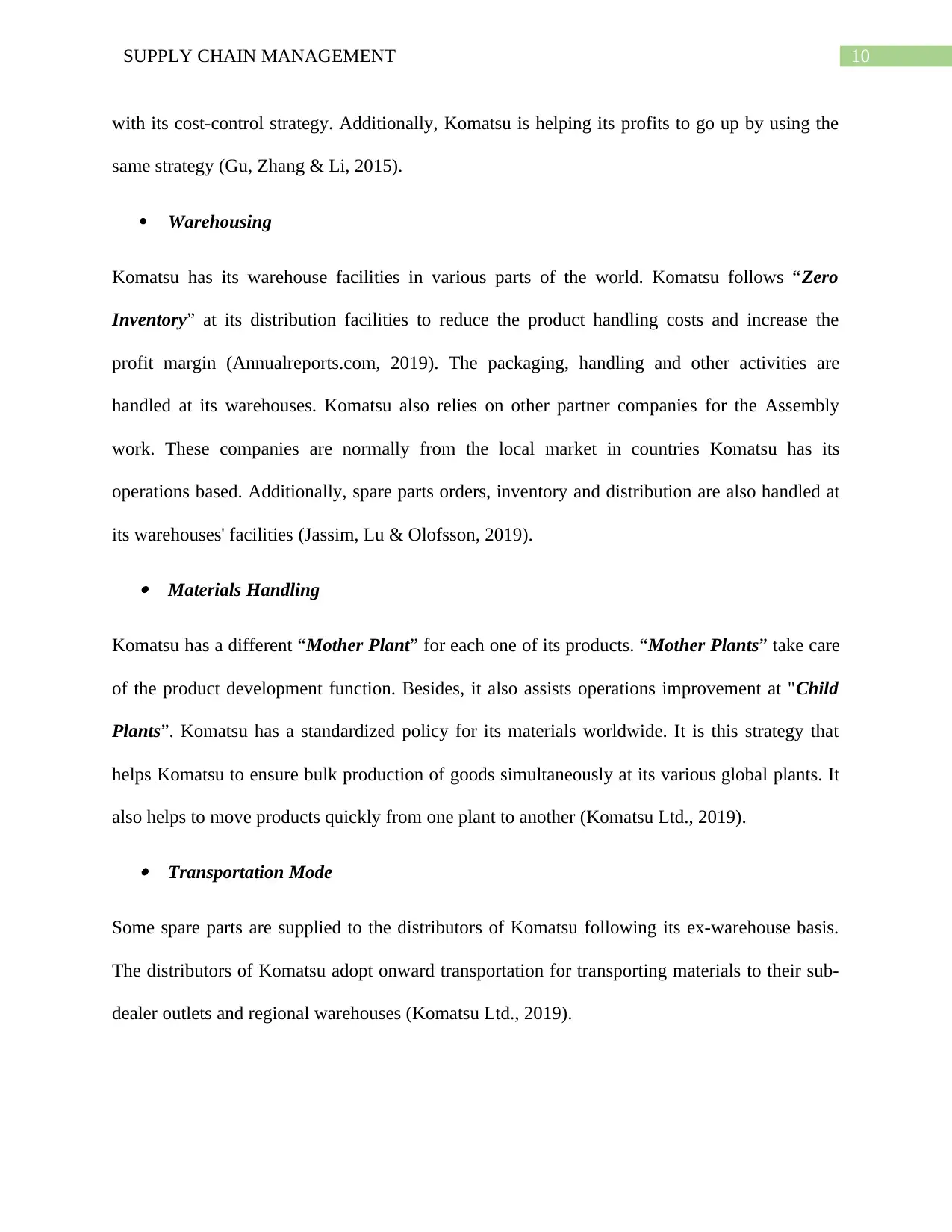
10SUPPLY CHAIN MANAGEMENT
with its cost-control strategy. Additionally, Komatsu is helping its profits to go up by using the
same strategy (Gu, Zhang & Li, 2015).
Warehousing
Komatsu has its warehouse facilities in various parts of the world. Komatsu follows “Zero
Inventory” at its distribution facilities to reduce the product handling costs and increase the
profit margin (Annualreports.com, 2019). The packaging, handling and other activities are
handled at its warehouses. Komatsu also relies on other partner companies for the Assembly
work. These companies are normally from the local market in countries Komatsu has its
operations based. Additionally, spare parts orders, inventory and distribution are also handled at
its warehouses' facilities (Jassim, Lu & Olofsson, 2019).
Materials Handling
Komatsu has a different “Mother Plant” for each one of its products. “Mother Plants” take care
of the product development function. Besides, it also assists operations improvement at "Child
Plants”. Komatsu has a standardized policy for its materials worldwide. It is this strategy that
helps Komatsu to ensure bulk production of goods simultaneously at its various global plants. It
also helps to move products quickly from one plant to another (Komatsu Ltd., 2019).
Transportation Mode
Some spare parts are supplied to the distributors of Komatsu following its ex-warehouse basis.
The distributors of Komatsu adopt onward transportation for transporting materials to their sub-
dealer outlets and regional warehouses (Komatsu Ltd., 2019).
with its cost-control strategy. Additionally, Komatsu is helping its profits to go up by using the
same strategy (Gu, Zhang & Li, 2015).
Warehousing
Komatsu has its warehouse facilities in various parts of the world. Komatsu follows “Zero
Inventory” at its distribution facilities to reduce the product handling costs and increase the
profit margin (Annualreports.com, 2019). The packaging, handling and other activities are
handled at its warehouses. Komatsu also relies on other partner companies for the Assembly
work. These companies are normally from the local market in countries Komatsu has its
operations based. Additionally, spare parts orders, inventory and distribution are also handled at
its warehouses' facilities (Jassim, Lu & Olofsson, 2019).
Materials Handling
Komatsu has a different “Mother Plant” for each one of its products. “Mother Plants” take care
of the product development function. Besides, it also assists operations improvement at "Child
Plants”. Komatsu has a standardized policy for its materials worldwide. It is this strategy that
helps Komatsu to ensure bulk production of goods simultaneously at its various global plants. It
also helps to move products quickly from one plant to another (Komatsu Ltd., 2019).
Transportation Mode
Some spare parts are supplied to the distributors of Komatsu following its ex-warehouse basis.
The distributors of Komatsu adopt onward transportation for transporting materials to their sub-
dealer outlets and regional warehouses (Komatsu Ltd., 2019).
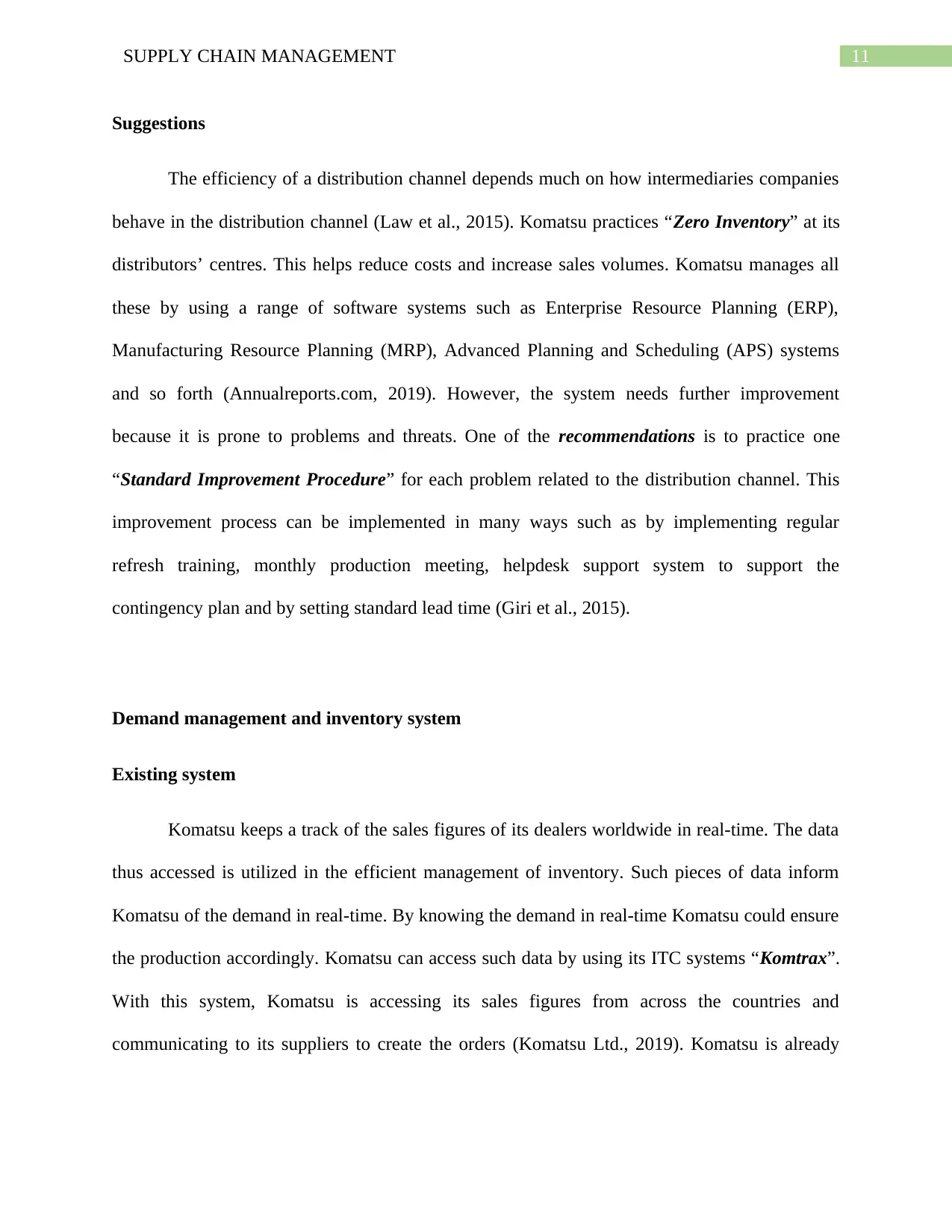
11SUPPLY CHAIN MANAGEMENT
Suggestions
The efficiency of a distribution channel depends much on how intermediaries companies
behave in the distribution channel (Law et al., 2015). Komatsu practices “Zero Inventory” at its
distributors’ centres. This helps reduce costs and increase sales volumes. Komatsu manages all
these by using a range of software systems such as Enterprise Resource Planning (ERP),
Manufacturing Resource Planning (MRP), Advanced Planning and Scheduling (APS) systems
and so forth (Annualreports.com, 2019). However, the system needs further improvement
because it is prone to problems and threats. One of the recommendations is to practice one
“Standard Improvement Procedure” for each problem related to the distribution channel. This
improvement process can be implemented in many ways such as by implementing regular
refresh training, monthly production meeting, helpdesk support system to support the
contingency plan and by setting standard lead time (Giri et al., 2015).
Demand management and inventory system
Existing system
Komatsu keeps a track of the sales figures of its dealers worldwide in real-time. The data
thus accessed is utilized in the efficient management of inventory. Such pieces of data inform
Komatsu of the demand in real-time. By knowing the demand in real-time Komatsu could ensure
the production accordingly. Komatsu can access such data by using its ITC systems “Komtrax”.
With this system, Komatsu is accessing its sales figures from across the countries and
communicating to its suppliers to create the orders (Komatsu Ltd., 2019). Komatsu is already
Suggestions
The efficiency of a distribution channel depends much on how intermediaries companies
behave in the distribution channel (Law et al., 2015). Komatsu practices “Zero Inventory” at its
distributors’ centres. This helps reduce costs and increase sales volumes. Komatsu manages all
these by using a range of software systems such as Enterprise Resource Planning (ERP),
Manufacturing Resource Planning (MRP), Advanced Planning and Scheduling (APS) systems
and so forth (Annualreports.com, 2019). However, the system needs further improvement
because it is prone to problems and threats. One of the recommendations is to practice one
“Standard Improvement Procedure” for each problem related to the distribution channel. This
improvement process can be implemented in many ways such as by implementing regular
refresh training, monthly production meeting, helpdesk support system to support the
contingency plan and by setting standard lead time (Giri et al., 2015).
Demand management and inventory system
Existing system
Komatsu keeps a track of the sales figures of its dealers worldwide in real-time. The data
thus accessed is utilized in the efficient management of inventory. Such pieces of data inform
Komatsu of the demand in real-time. By knowing the demand in real-time Komatsu could ensure
the production accordingly. Komatsu can access such data by using its ITC systems “Komtrax”.
With this system, Komatsu is accessing its sales figures from across the countries and
communicating to its suppliers to create the orders (Komatsu Ltd., 2019). Komatsu is already
⊘ This is a preview!⊘
Do you want full access?
Subscribe today to unlock all pages.

Trusted by 1+ million students worldwide
1 out of 19